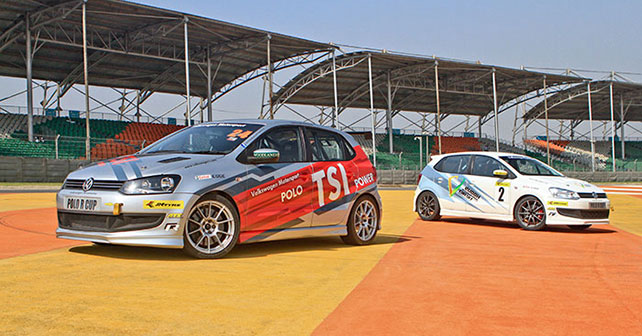
With the advent of the second generation Polo R Cup racing car, we get a unique opportunity to take both the previous and current gen cars out on the BIC to sample them back-to-back.
VW’s participation in the Indian racing arena has been a godsend for Indian motorsports. What earlier consisted of largely amateur efforts, and some half-hearted participation by selected Indian companies, was suddenly revolutionized by the entry of a professional racing outfit that was not only interested in promoting its own brand, but also promoting motorsports on the whole. The only Indian company that has done this consistently has been JK Tyres – who provide especially developed racing slicks for the Polo racecars.
From the days of drivers fending for themselves, we saw a new era where not only were the drivers given cutting edge hardware to race in, but were also groomed. For the first time, we had driver training camps and experts imparting knowledge – not only on how to perform better on-track, but also what’s needed to be a successful racing driver on an international level.
It was no surprise then, that after two successful seasons of racing the Polo Cup with the 1.6 diesel engines, VW thought of upping the ante by swapping the cars for the even faster petrol powered cars running in the current season. So, instead of the 130bhp diesel, the Polo’s are now powered by a cutting edge 1.4 litre petrol turbocharged and supercharged engine, which puts out a staggering 180bhp and 250Nm of torque.
Sure, one might think – compared to many road cars today – those figures aren’t that impressive, but keep in mind the Polo R Cup is an out-and-out racecar. Every single ounce of weight that was redundant has been stripped out of the car, including most of the interiors, door panels, seats, carpets, et al. The objective here is to make the car lighter, faster and more capable on the track.
And to be honest, they are immensely capable. Fitted with a 6-speed DSG gearbox and a limited slip differential, the current petrol powered car is simply mega to drive on the track. The slick tyres, along with the race-spec suspension, makes the driving experience like no other road car. The car is nimble on its feet and the steering is immediate. There’s an abundance of grip, coupled with rather effective brakes, that makes taking the slow-in-fast-out approach a cinch. You carry massive speed though the corners, and this makes the driving experience very exciting. What helps is the feeling of being strapped tight into a full race-spec seat with a proper 5-point racing harness. Ordinarily, you might wonder why there’s a need to strap in via a 5-point harness, but one hard braking manoeuver at race speeds where your chest and torso suddenly decide to leave the seat and become best friends with the belts, and it becomes abundantly clear why the race harness is an absolutely necessity in a car like this.
However, given what a hoot the older diesel car was to drive, how does the new one compare? Well, to be honest, we think the older car was far more involving to drive than the new TSI powered Polo. Sure, the new one has much more power, more technology, and a high revving petrol engine, but the older diesel engine with its manual gearbox was more thrilling drive as the three-pedal arrangement meant that the driver had to do much more of the work, whereas in the new car the DSG box takes care of the shifting.
Secondly, the diesel powered car had a much more mobile rear end compared to the petrol version, and that made the car more fun to drive. Plus, it let the drivers learn a lot about car control. But while the new car may not be as physical, it’s a good lesson in clinical driving – with the LSD helping in putting the power down when coming out of corners.
Our nostalgia and affection for the older car aside, the newer car is quite useful as a platform for drivers who intend to continue their racing careers in Europe and beyond – given that modern racecars are now exclusively equipped with automatic transmissions. And while the Polo R Cup may be a long way off from the next rung of racing, it is one the best – if not the best – platform for aspiring racing to cut their teeth in.
In terms of sheer performance, we managed to lap the Polo R Cup, on a dusty track, at 2:32.3 – compare that with 2:48.5 for the new Polo GT TSI, and 2:42.0 for the diesel Polo, and you get some sense of its relative performance. So, lets hope we see more Indian drivers graduate from the Polo Cup and find their way on podiums in Europe. In the meantime, us hacks will continue to relish any and all opportunities to get behind the wheel of these wonderful race machines – even while we rue our lost chance of becoming the next Senna or Schumacher!

















Write your Comment